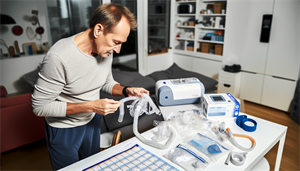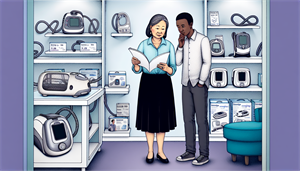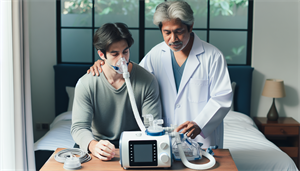Does insurance cover sleep apnea machines? In many cases, the answer is yes. Insurance policies, including Medicare and Medicaid, often cover CPAP therapy with certain conditions. This article will navigate the specifics of insurance coverage for CPAP machines, outlining what you need to do to get your treatment covered.
Key Takeaways
-
Most insurance providers, including Medicare and Medicaid, partially cover CPAP therapy for sleep apnea, but eligibility and compliance requirements must be met, and patients may face out-of-pocket costs including deductibles.
-
Insurance coverage for CPAP machines includes key supplies like masks, tubing, and filters, with limitations on optional accessories and varying replacement schedules that can affect costs.
-
Navigating insurance for CPAP therapy requires understanding individual policy details, working with medical providers for documentation, and ensuring regular maintenance and adherence to therapy for continued coverage.
Exploring Insurance Coverage for CPAP Therapy

Most insurance providers, including Medicare and Medicaid, recognize the benefits of continuous positive airway pressure (CPAP) therapy for managing sleep apnea and typically cover a portion of the cost of a CPAP machine. However, it’s not as simple as just filing a claim. There’s a maze of requirements to navigate, from proving medical necessity to meeting compliance standards. Moreover, insurance coverage often involves a rental period for the machine, after which the individual takes ownership. This means that despite insurance coverage, there might be out-of-pocket expenses before the insurance pitches in, particularly if you haven’t met your deductible.
Understanding your insurance plan can significantly reduce your out-of-pocket costs. So, let’s start by examining the specifics of various insurance providers, including your chosen insurance company, with a focus on health insurance first.
Deciphering Your Health Insurance Plan
While health insurance plans often cover CPAP machines, the extent of coverage can vary based on factors like deductibles, copayments, and coinsurance. The concept of an out-of-pocket maximum plays a pivotal role here. This is the total annual sum you’re responsible for paying before your insurance provider takes on 100 percent coverage for all eligible services. If you cross your annual deductible, you might find the cost of replacement parts for your CPAP machine substantially discounted or even entirely covered.
A thorough grasp of your health plan and benefits will clarify the coverage extent for CPAP equipment or services. It ensures you’re aware of your responsibilities and the exact amount your insurance policy will cover. Next, we’ll delve into the details of Medicare coverage.
Navigating Medicare's CPAP Benefits
Medicare offers coverage for CPAP therapy, but it does come with strings attached. To qualify, you need to:
-
Have been diagnosed with moderate or severe obstructive sleep apnea
-
Undergo a sleep study
-
Have a face-to-face appointment with a physician who attests to the need for CPAP therapy and the potential for surgery without it.
To maintain Medicare coverage, you need to meet the compliance requirements, which include:
-
Using the CPAP machine for a minimum of 4 hours per night, at least 70% of the time, during the initial 3 months of therapy.
-
Medicare covers 80% of the cost, with the remaining 20% coinsurance falling onto the beneficiaries once the Part B deductible is met.
-
If you fail to meet the compliance requirements, you would need to restart the process, which includes undergoing a new sleep study and obtaining a new prescription from your physician.
What about Medicaid coverage? Let’s explore that next.
Medicaid's Stance on CPAP Coverage
CPAP machines are covered by Medicaid, although the level of coverage can differ between states. To qualify for CPAP coverage under Medicaid, you need to have a confirmed diagnosis of obstructive sleep apnea through a sleep test and a prescription from a sleep medicine doctor outlining the required settings and accessories for CPAP treatment.
The rules and requirements for CPAP coverage under Medicaid can differ greatly across different states, so it’s advisable to consult your local Medicaid office or provider to ascertain the specific guidelines applicable to your state. If you’re unsure about the specifics of your state’s Medicaid program, it’s always a good idea to contact the office directly to get the information you need.
The Journey to Getting a CPAP Machine Covered

With a clear understanding of your insurance plan’s approach to CPAP coverage, you can then proceed to secure coverage for your CPAP machine. This typically involves obtaining a prescription from a physician and undergoing a sleep study to demonstrate medical necessity.
Insurance companies often require proof of a chronic condition linked to sleep apnea, such as an apnea-hypopnea index (AHI) of 5-14 for mild cases or an AHI of 15 or higher for moderate to severe cases. Furthermore, most insurance plans cover a part of the costs linked to sleep studies, an integral part of diagnosing sleep apnea.
Prescription and Proof of Sleep Apnea Diagnosis
A valid prescription and sleep study are the first steps towards confirming a sleep apnea diagnosis and qualifying for insurance coverage. This entails obtaining a CPAP prescription after verifying a sleep apnea diagnosis, typically involving a polysomnogram (PSG), an overnight in-lab sleep study that evaluates symptoms and sleep history.
The prescription and diagnosis not only help you secure coverage but also ensure that your CPAP therapy is tailored to your specific needs. Remember, each individual’s sleep apnea condition is unique, and the CPAP machine settings need to be adjusted accordingly for effective treatment.
Meeting Compliance Requirements
After obtaining coverage for your CPAP machine, it’s essential to follow the compliance requirements established by your insurance provider to keep this coverage. This typically includes regular and correct usage of the CPAP machine, often at least four hours each night for a minimum of five nights a week.
Failure to meet these requirements could result in discontinuation of coverage. If you’re struggling with consistent use of your CPAP machine, you could consider a cpap machine rental for a trial period or seeking advice from sleep coaches to help you meet your insurance policy’s compliance goals.
CPAP Equipment and Supply Coverage Specifics

Insurance coverage for CPAP equipment extends beyond the machine itself. With insurance cover CPAP equipment, it usually includes the supplies required for proper usage of the device, such as:
-
Masks
-
Tubing
-
Headgear
-
Filters
However, it’s important to note that optional accessories and cleaning supplies are often not covered by insurance cover, and there might be limitations on the coverage for necessary supplies.
It’s vital to comprehend the details of coverage for CPAP equipment and supplies, including the effects of replacement schedules and coverage limitations. It not only helps you manage your expenses better but also ensures that you have all the necessary equipment for effective CPAP therapy.
Replacement Schedules and Insurance Policies
Effective therapy largely depends on the replacement schedules for CPAP supplies. Insurance providers typically adhere to a schedule for covering the replacement costs of CPAP supplies when they are used as directed by a doctor.
These schedules vary for different supplies, with tubing replaced every three months and masks, cushions, and headgear replaced every 6-12 months. By comparing replacement schedules against deductible and out-of-pocket maximum, you can effectively strategize the timing of replacements for your durable medical equipment to reduce costs, potentially leading to savings.
Understanding the Limits of Coverage
While insurance coverage typically includes the machine and necessary CPAP supplies, there are often limitations. For instance, Medicaid and Medicare offer partial coverage for CPAP machines across all three AHI indexes, subject to specific conditions. Moreover, coverage for optional CPAP accessories may not be included in insurance plans. It is essential to understand your insurance cover CPAP machines benefits to ensure you receive the appropriate support.
Knowing these limitations is imperative to plan your expenses effectively and prevent unforeseen costs. Remember, while insurance can cover a significant part of your CPAP therapy costs, it’s not a blanket coverage, and understanding the fine print is key to avoiding any surprises.
Costs and Considerations for CPAP Users

While understanding insurance coverage for CPAP therapy is crucial, considering the associated costs, including out-of-pocket expenses and alternatives for those without insurance, is equally significant.
Whether you’re insured or not, the cost of a CPAP machine can be a significant investment. The typical out-of-pocket cost for a CPAP machine ranges from $750 to $1,400, even with insurance coverage. If you lack insurance, it’s necessary to investigate other avenues to make CPAP therapy more affordable.
Analyzing Out-of-Pocket Costs
Out-of-pocket costs for CPAP machines and supplies can vary depending on insurance coverage and individual policies. Here are some typical costs:
-
CPAP machine: $750 to $1,400
-
Masks: covered by most insurance plans
-
Tubing: covered by most insurance plans
-
Headgear: covered by most insurance plans
-
Filters: covered by most insurance plans
However, individuals may incur out-of-pocket costs for cleaning supplies and other accessories.
Furthermore, the impact of deductibles and copayments on CPAP therapy costs can’t be ignored. These factors play a significant role in determining the overall cost of CPAP therapy. Therefore, understanding these costs and planning for them can help manage your budget effectively.
Options for Uninsured or Underinsured Patients
If you’re uninsured or underinsured, the cost of CPAP therapy can be a considerable burden. However, there are options available. For instance, if you’re uninsured, you can still acquire CPAP equipment provided you obtain a prescription from a physician and can cover the entire cost on your own.
There are also organizations and foundations that offer assistance with CPAP therapy costs for individuals who are uninsured or underinsured. Additionally, underinsured individuals can access discounted CPAP supplies through various assistance programs and organizations that provide these machines and supplies at reduced rates.
Transitioning to CPAP Therapy: A Guide for New Users

Starting CPAP therapy can be a daunting experience, especially when you’re trying to navigate the insurance landscape. Nevertheless, understanding the process can help ease the transition and ensure effective treatment.
From choosing a reputable supplier to setting up your machine correctly, there’s a lot to consider. This section is a guide intended to help new CPAP users transition smoothly into the therapy.
Selecting a CPAP Supplier
Choosing the right CPAP supplier is crucial for ensuring you get the proper equipment and support throughout your therapy process. Factors to consider when choosing a CPAP supplier include:
-
Reputation of the manufacturer
-
Quality of CPAP supplies
-
Type of mask and device
-
Competitive pricing
-
Availability of clinical support
-
Reliable after-sales service
Taking these factors into account will help you find a CPAP supplier that meets your needs.
Some examples of reliable suppliers include:
-
Cascade Sleep Supply
-
Oregon Sleep Associates
-
RespShop
-
Bellevue Healthcare
-
Grove Medical Equipment & Supplies
Remember, investing time in choosing the right supplier can pay off in the long run, ensuring you receive quality equipment and the support you need.
Setting Up Your CPAP Machine
Correct setup of your CPAP machine is a prerequisite for effective treatment. Here are the steps to follow:
-
Position yourself on the edge of the bed with the mask straps loosely positioned on your face.
-
Once lying down, find a suitable location for the CPAP machine.
-
Attach the filter, hose, and mask.
-
Make necessary adjustments to the mask to ensure comfort and proper fit.
When making adjustments to CPAP pressure settings, consider factors such as:
-
The severity of sleep apnea
-
Throat muscle anatomy
-
Preferred sleep position
-
Changes in sleep stages throughout the night
Remember, the effectiveness of your therapy depends on the proper setup and adjustment of your CPAP machine.
Maximizing Insurance Benefits for CPAP Adherence
To fully leverage your insurance benefits for CPAP therapy, you need more than a mere understanding of your coverage. It necessitates a strong partnership with your medical provider, regular upkeep of your CPAP machine, and consistent check-ups.
Your medical provider can assist in navigating the insurance process, including:
-
Coverage verification
-
Obtaining prior authorizations
-
Making appeals
-
Providing guidance on cost-effective equipment covered by insurance
Regular maintenance and proper disinfection of your CPAP machine are essential for its optimal functioning and hygiene, which is critical for maintaining consistency in therapy and insurance coverage.
Working With Your Medical Provider
A close collaboration with your medical provider can help maximize your insurance benefits. They can ensure accurate completion and timely submission of documentation and paperwork, which is crucial for insurance coverage. Moreover, they can assist in navigating the insurance process, including coverage verification, obtaining prior authorizations, making appeals, and providing guidance on cost-effective equipment covered by insurance.
Remember, your medical provider is your ally in this journey, and their support can be invaluable in securing and maintaining your insurance coverage for CPAP therapy.
Regular Maintenance and Insurance Check-Ups
Maintaining your CPAP machine regularly is crucial for optimal performance and an extended lifespan. This involves:
-
Ensuring proper cleaning and disinfection
-
Replacing the CPAP mask, cushions, and headgear every 6-12 months
-
Replacing tubing at least annually
-
Performing weekly cleaning of the machine and water chamber
Regular check-ups with your healthcare provider are also crucial. They involve:
-
Verifying your adherence to CPAP therapy
-
Checking the proper functioning of the CPAP machine
-
Confirming the effectiveness of the treatment in managing potential complications of obstructive sleep apnea
Adhering to these appointments is often a requirement for maintaining insurance coverage.
Summary
Navigating insurance coverage for CPAP therapy can seem like a daunting task, but with the right guidance, it becomes manageable. Understanding your insurance plan, meeting compliance requirements, selecting a reputable supplier, and performing regular maintenance are all vital steps in ensuring successful CPAP therapy. Always remember to discuss any concerns or issues with your healthcare provider and insurance company to ensure you’re getting the most out of your therapy and insurance coverage.
Frequently Asked Questions
How often will insurance pay for a CPAP machine?
Insurance will typically cover a new CPAP machine every three to five years, with the possibility of needing a new sleep study before authorization, to ensure the continued need for the device and appropriate settings. Medicare and most other insurers usually provide coverage for a new CPAP machine after approximately 5 years of use.
Why does insurance not cover CPAP machines?
Insurance does not cover CPAP machines because they are prescription-only devices, and a doctor must issue a prescription following a sleep study before insurance will cover the treatment.
How do you qualify for a CPAP machine?
To qualify for a CPAP machine, you need to have a diagnosis of obstructive sleep apnea (OSA) from your doctor, based on a sleep study and review of your symptoms and test results.
How much does it cost to get a sleep apnea machine?
A sleep apnea machine can cost around $750 to $800 on average, including the necessary supplies and setup. Additional costs may vary depending on the specific device and accessories needed.
How do insurance providers typically handle coverage for CPAP machines?
Insurance providers typically cover a portion of the cost of a CPAP machine, based on medical necessity and adherence to CPAP therapy.


